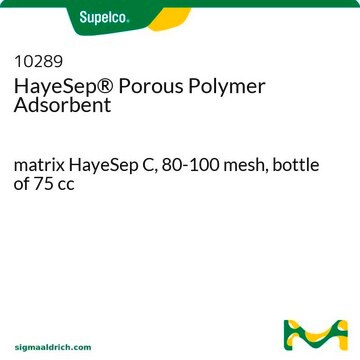10289
HayeSep® Porous Polymer Adsorbent
matrix HayeSep C, 80-100 mesh, bottle of 75 cc
About This Item
Recommended Products
form
solid
packaging
bottle of 75 cc
parameter
250 °C temp. limit
technique(s)
gas chromatography (GC): suitable
surface area
~442 m2/g
matrix
HayeSep C
particle size
80-100 mesh
density
~0.32 g/mL (free fall density)
Looking for similar products? Visit Product Comparison Guide
1 of 4
This Item | 10290 | 10303 | 10292 |
|---|---|---|---|
| surface area ~442 m2/g | surface area ~485 m2/g | surface area ~344 m2/g | surface area ~795 m2/g |
| form solid | form solid | form liquid | form solid |
| matrix HayeSep C | matrix HayeSep C | matrix HayeSep R | matrix HayeSep D |
| packaging bottle of 75 cc | packaging bottle of 75 cc | packaging bottle of 75 cc | packaging bottle of 75 cc |
| parameter 250 °C temp. limit | parameter 250 °C temp. limit | parameter 250 °C temp. limit | parameter 290 °C temp. limit |
General description
For more information about any of our adsorbents, please visit sigma-aldrich.com/adsorbents
Application
Legal Information
Storage Class
11 - Combustible Solids
wgk_germany
nwg
flash_point_f
Not applicable
flash_point_c
Not applicable
ppe
dust mask type N95 (US), Eyeshields, Gloves
Choose from one of the most recent versions:
Certificates of Analysis (COA)
Sorry, we don't have COAs for this product available online at this time.
If you need assistance, please contact Customer Support.
Already Own This Product?
Find documentation for the products that you have recently purchased in the Document Library.
Our team of scientists has experience in all areas of research including Life Science, Material Science, Chemical Synthesis, Chromatography, Analytical and many others.
Contact Technical Service











